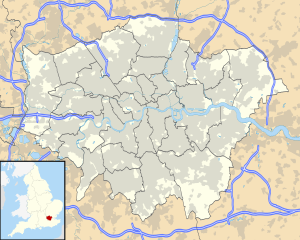Hungerford Bridge
Coordinates: 51 ° 30 ′ 22 ″ N , 0 ° 7 ′ 12 ″ W.
| Hungerford Bridge | ||
|---|---|---|
| Hungerford Bridge, looking east | ||
| use | Railway bridge, pedestrian bridges on both sides | |
| Crossing of | Thames | |
| place | London | |
| location | ||
|
|
||
Hungerford Bridge (also Charing Cross Bridge ) is a railway bridge over the River Thames in London . The steel lattice bridge forms the main access to the Charing Cross terminus and is flanked on both sides by pedestrian bridges , which are called Golden Jubilee Bridges .
history
The Hungerford Bridge was originally designed by Isambard Kingdom Brunel . It was opened in 1845 as a pure pedestrian connection and acquired in 1859 by the South Eastern Railway , which built the new Charing Cross station on the north bank. The railway company had the suspension bridge replaced with a new iron grating structure by John Hawkshaw , which opened in 1864. The suspension chains were reused on the Clifton Suspension Bridge . The brick pillars of Brunel's suspension bridge were preserved. The northern pillar has been significantly closer to the river bank since the Victoria Embankment Road was built in 1870, while the stairs leading down to the former landing stage of the steamers still exist on the southern pillar. The toll on the pedestrian bridge was lifted in 1878.
The narrow footbridge had a reputation for being shabby and dangerous at night. In the mid-1990s it was decided to replace them with two new structures on both sides of the railway bridge. Construction began in 1996 and lasted until 2002. The new bridges were called Golden Jubilee Bridges , in honor of Queen Elizabeth II's golden jubilee in the same year.
Web links
- Hungerford Bridge (railroad). In: Structurae
- Hungerford Bridge (pedestrians). In: Structurae
- William Humber: A Complete Treatise on Cast and Wrought Iron Bridge Construction ; Description of the Charing Cross Bridge (1864), pp. 234–237. Lockwood & Co., London 1870. Digitized on Google Books
|
Upstream Westminster Bridge Tunnel on the Bakerloo Line |
River crossings of the Thames |
Downstream tunnel of the Northern Line Waterloo Bridge |


